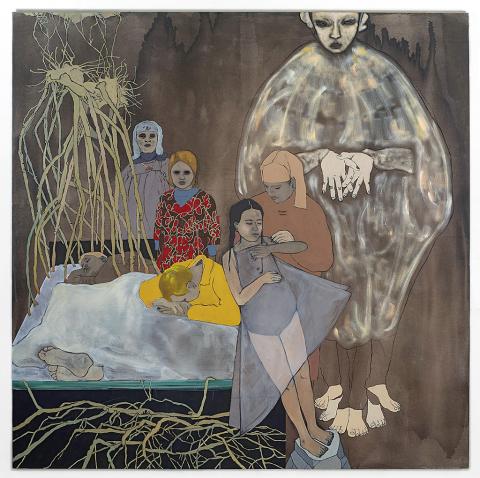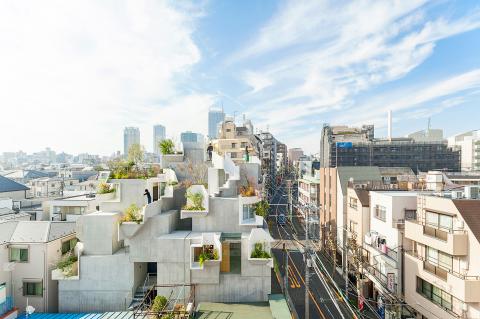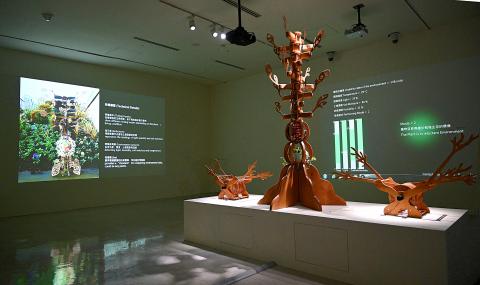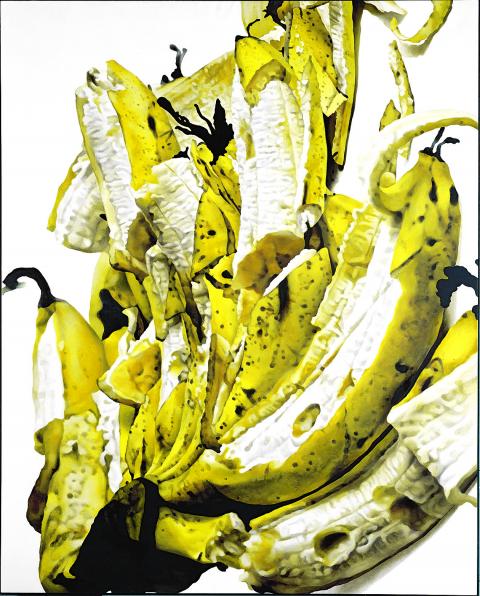Nunu Fine Art (路由藝術) presents Fare Well (道別之後), a solo exhibition by English artist Maya Hewitt. Hewitt is a prolific painter who creates figurative and landscape paintings influenced by her Filipino heritage as well as her interests in Japanese culture. Her work often embodies narratives of suspense, capturing strange events in moments of anticipation as they linger between the real and the fictional, the human and the artificial and the natural and the supernatural, writes the gallery. The show features a selection of recent paintings that continue Hewitt’s ongoing reflections on the existence of humans and the universe. Hewitt’s paintings often refer to real-life experiences, and in this show many of the works reference rituals related to life and death. New Borns depicts two women sitting across from each other playing with puppets and a collection of anatomical dolls. Stay with Me shows a scene of mourning next to a reclining body. These memories touch upon emotional experiences that speak to the relationship between the material and spiritual world.
■ Nunu Fine Art (路由藝術), 5, Ln 67, Jinshan S Rd Sec 1, Taipei City (台北市金山南路一段67巷5號), tel: (02) 3322-6207. Open Wednesdays to Sundays from noon to 7pm
■ Until May 5

Photo Courtesy of Nunu Fine Art
Desire Obtain Cherish (D.O.C.), otherwise known as Jonathon Paul, is an American who began his career as a street artist in Los Angeles. He now works in street, pop and appropriation art to create multimedia projects that are satirically provocative. D.O.C’s third solo exhibition at Blurerider Art (藍騎士藝術空間), Off-Gassing From the Cloud (雲端世界如彩虹般迷幻), presents a new series of paintings and installations that examine our cloud technology-dependent lifestyle. The artist examines the psychological processes of consumerism and the nature of excessive Internet-based data streams.
■ Bluerider Art (藍騎士藝術空間), 9F, 25-1, Renai Rd Sec 4, Taipei City (台北市仁愛路四段25-1號9樓), tel: (02) 2752-2238. Open Tuesdays to Saturdays from 9am to 6pm.
■ Until April 30

Photo Courtesy of Yukikazu Ito
As part of an exhibition series showcasing mid-career architects working around the world, Jut Art Museum (忠泰美術館) presents Human Nature (人間自然), a solo exhibition by award-winning Japanese architect Akihisa Hirata. Hirata worked in the prestigious architectural firm Toyo Ito & Associates before launching his own firm in 2005. The show presents 12 recent projects that demonstrate his unique vision. The idea of nature is openly discussed in the curatorial statement, which proposes many kinds of nature — including a “worldly” nature, a “synthetic” nature and a “genuine” nature. For Hirata, architecture is about systems of ecologies in which things are interrelated. Within each ecology, there is a continual process of change and interaction between natural and human-made elements. While designing, Hirata consciously takes on a macroscopic view of the world and considers humans just another species inhabiting the earth, thus transcending human subjectivity. The show invites visitors to consider the future of the planet in relation to human civilization.
■ Jut Art Museum (忠泰美術館), 178, Civic Blvd Sec 3, Taipei City (台北市市民大道三段178號), tel: (02) 8772 6178. Open Tuesdays to Sundays from 10am to 6pm
■ Until June 23

Photo Courtesy of National Taiwan Museum of Fine Arts
Post-Digital Anthropocene (後數位人類紀) is a collaboration between the National Taiwan Museum of Fine Arts (國立台灣美術館) and the Madrid-based digital art festival MADATAC, and features 12 artists from Spain and Taiwan. The anthropocene is a geological term used to describe the current epoch of accelerating human impact on the natural environment. The show presents works that respond to today’s global crisis through various mediums, such as objects, images, hypertext and automated installations. According to curators Iury Lech and Chiu Chi-yung (邱誌勇), the exhibition showcases two significant trends of contemporary art: the rapidly evolving digital arts that progress with the advancement of technology and the kind of non-digital arts that reflect upon today’s issues of human survival. As a whole, artists today are steering away from representations and symbols and focusing more on process-oriented practices of generation, write the curators. The show offers an impression of the contemporary era through bodily and sensory experiences.
■ National Taiwan Museum of Fine Arts (國立台灣美術館), 2, Wuquan W Rd Sec 1, Taichung City (台中市五權西路一段2號), tel: (04) 2373-3552. Open Tuesdays to Fridays from 9am to 5pm, Saturdays and Sundays from 9am to 6pm.
■ Until June 16

Photo Courtesy of Chimei Museum
In celebration of its 30th Anniversary, Chimei Museum (奇美博物館) has invited art historian Hsiao Chong-ray (蕭瓊瑞) to curate an ambitious retrospective of Taiwanese art. Hyperrealism Art in Taiwan (奇麗之美 — 臺灣精微寫實藝術大展) focuses on local developments of hyperrealism, as well as other trends of realism, in the 20th century. The genre stems from Western photorealistic and surrealist techniques and includes paintings and sculptures that resemble high-resolution photographs. Hyperrealist art is known for its precision and fine details that push the boundaries of representation. The show includes a range of works that cover four thematic points, which are the figure, still life, landscape and dreamscape. Show highlights include Cho Yeou-jui’s (卓有瑞) Banana Series #7 (香蕉系列之七), which depicts a clutter of ripe bananas that have been violently peeled open. The work is part of a four-year painting series that examines the fragility of life through the metaphor of fruit. Chuang Suo’s (莊索) Refugees (難民) is a panorama of ordinary people, young and old, carrying their belongings and fleeing great turmoil. Szeto Keung’s (司徒強) Left + Right (左+右) is an acrylic-on-canvas work that depicts unassuming compositions of daily objects, as if made by accident. For Szeto, the traces we leave behind make up the meaning of life.
■ Chimei Museum (奇美博物館), 66, Wenhua Rd Sec 2, Tainan City (台南市文華路二段66號), tel: (06) 266-0800. Open Tuesdays to Thursdays from 9:30am to 5:30pm
■ Tomorrow until June 11

Even by the standards of Ukraine’s International Legion, which comprises volunteers from over 55 countries, Han has an unusual backstory. Born in Taichung, he grew up in Costa Rica — then one of Taiwan’s diplomatic allies — where a relative worked for the embassy. After attending an American international high school in San Jose, Costa Rica’s capital, Han — who prefers to use only his given name for OPSEC (operations security) reasons — moved to the US in his teens. He attended Penn State University before returning to Taiwan to work in the semiconductor industry in Kaohsiung, where he

On May 2, Chinese Nationalist Party (KMT) Chairman Eric Chu (朱立倫), at a meeting in support of Taipei city councilors at party headquarters, compared President William Lai (賴清德) to Hitler. Chu claimed that unlike any other democracy worldwide in history, no other leader was rooting out opposing parties like Lai and the Democratic Progressive Party (DPP). That his statements are wildly inaccurate was not the point. It was a rallying cry, not a history lesson. This was intentional to provoke the international diplomatic community into a response, which was promptly provided. Both the German and Israeli offices issued statements on Facebook

May 18 to May 24 Pastor Yang Hsu’s (楊煦) congregation was shocked upon seeing the land he chose to build his orphanage. It was surrounded by mountains on three sides, and the only way to access it was to cross a river by foot. The soil was poor due to runoff, and large rocks strewn across the plot prevented much from growing. In addition, there was no running water or electricity. But it was all Yang could afford. He and his Indigenous Atayal wife Lin Feng-ying (林鳳英) had already been caring for 24 orphans in their home, and they were in

Australia’s ABC last week published a piece on the recall campaign. The article emphasized the divisions in Taiwanese society and blamed the recall for worsening them. It quotes a supporter of the Taiwan People’s Party (TPP) as saying “I’m 43 years old, born and raised here, and I’ve never seen the country this divided in my entire life.” Apparently, as an adult, she slept through the post-election violence in 2000 and 2004 by the Chinese Nationalist Party (KMT), the veiled coup threats by the military when Chen Shui-bian (陳水扁) became president, the 2006 Red Shirt protests against him ginned up by